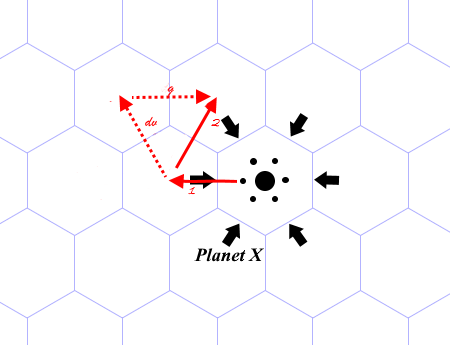
When I saw the crowdfunded revival of Triplanetary, two ideas struck. First, gosh that movement system is elegant. Second, oh, that's what Mayday (the Traveller small-scale space wargame) was supposed to be doing!
As I played with the game, it took me several tries to master some essential features of that movement system. When I looked to the all-powerful internet for advice, I found little that served my questions. So I have taken it upon myself to catalog my discoveries here, shared for the benefit of all. Maybe I'm spoiling some sort of "rite of passage" for learning this game. If so, too bad, still doing it.
The material presented here is my original creation, intended for use with the Triplanetary game from Steve Jackson Games. See the game page for the 2018 Third Edition rules, which this material will reference. This material is not official and is not endorsed by Steve Jackson Games.
See "Astrogation" in the rules, pp. 2-3. I don't really have anyhing to add here.
See "Gravity" in the rules, pg. 3. The explanation of gravity in and of itself is fine, if you intend to just fly past an astral body. My challenges came in proximity to astral bodies, as we'll touch on below.
To summarize "Landing and Takeoff", paragraphs 2 and 3 on page 4: Takeoff from a world (shown here, Planet X) into orbit is a 2-turn process.

Departure for a deep space destination would be a third or later turn. Important to have these things in mind if you're in a race.
About my diagrams: I find it easiest do draw the momentum vectors (p) first, then any gravity vectors (g). Then I can apply my thrust vector (dv) to set the destination hex. Since vector addition is commutative and distributive, the outcome is the same no matter the ordering or the grouping. In Fig. 1, I've put the thrust vector first for clarity.
On page 4, "Orbit", paragraph 1, says that any vehicle moving at one hex per turn from a hex with a gravity arrow to an adjacent hex with a gravity arrow is in orbit and can continue to move in orbit indefinitely without spending fuel. The mechanics of continued orbit are very ably described by the late Professor Nyrath here (fifth illustration). My problem was getting to that state, not understanding that state once achieved.
The expanded description for Launch to Orbit above shows the mechanics for entering orbit on liftoff. I discuss entering orbit from deep space below in Approach and Orbit.
To summarize "Landing and Takeoff", paragraph 4: Landing on a world from orbit is a 1-turn, 1-fuel point process: Spend a fuel point, land at any hex side with a base. Let me point out the importance of choosing a landing base that makes takeoff to your next destination an efficient one (more discussion to come).
The rules do not support landings directly from deep space, even at speed 1. Speed kills. You must slow to orbital speed first.
"Here's where the fun begins."
This is by far the simplest and most efficent way to enter orbit from spaceside. Enter a gravity hex with an ending speed of 1 hex per turn. On the next turn, momentum carries you to the adjacent hex, but gravity pulls you "down/along." Spend 1 fuel point to counter the gravity vector. Result: Movement from one gravity hex to another at 1 hex per turn. Orbit established, cost 1 fuel, 1 turn.
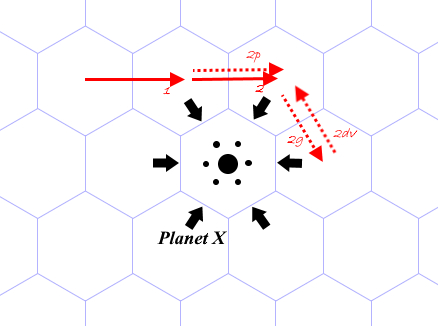
Enter a gravity hex with an ending speed of 1, pointing directly at the astral body. Yikes! Momentum would pull you into the body; gravity speeds you through to the opposite gravity hex. Thrust back toward the astral body to one side or the other, depending on the orbital direction you prefer. You will narrowly miss the body and finish in a gravity hex. On the following turn, momentum wants to take you further out, but the two gravity hexes passed from the previous turn pull you back. Spend 1 fuel point to hit your adjacent gravity hex at speed 1. Orbit established, cost 2 fuel, 2 turns.
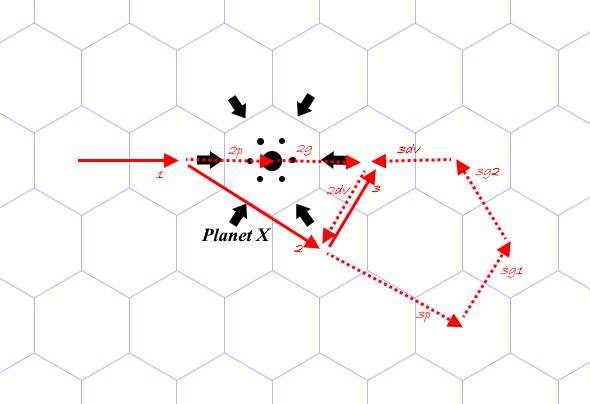
Head-on approaches at speeds higher than 1 will not lead to orbit … more likely to impact, especially near giant planets or stars. Not recommended.
This is a similar solution to Speed 1, Head On, just rotated a bit. Cost 2 fuel, 2 turns.
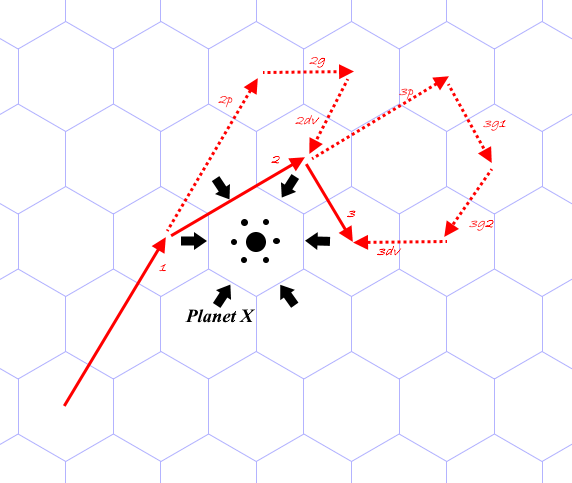
It might seem trite to say, but you want to leave orbit pointed at your destination. Working backwards, that means get-away fuel needs to be applied one hex ahead of that line. And if you're launching from the ground, that means you should have chosen to land at a base 120 degrees around from the desired flight line.
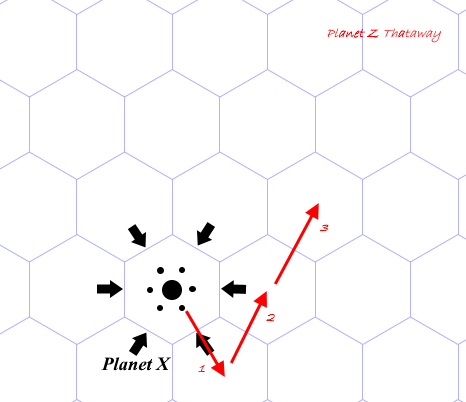
Remember to allow for time. It's three turns just to get away from an astral body, and two more to put down on one IF you've controlled your approach appropriately.
Space travelers say "Delta-v is life." Translated for Triplanetary, "Fuel points are life." Don't just spend them, PLAN how they are to be spent. Or recovered.
The simple Triplanetary movement rules develop lush and subtle nuances in application. It may not be strictly accurate to physics, but it captures the same kinds of problems for which real space navigators must plan. I hope the basic examples above prove useful to the novice, or even experienced, player. I leave the rest of the discoveries as exercises for the reader. Clear skies and hot jets!
Copyright 2018, 2020, 2022, 2023 W. Robert Portnell. All rights reserved.